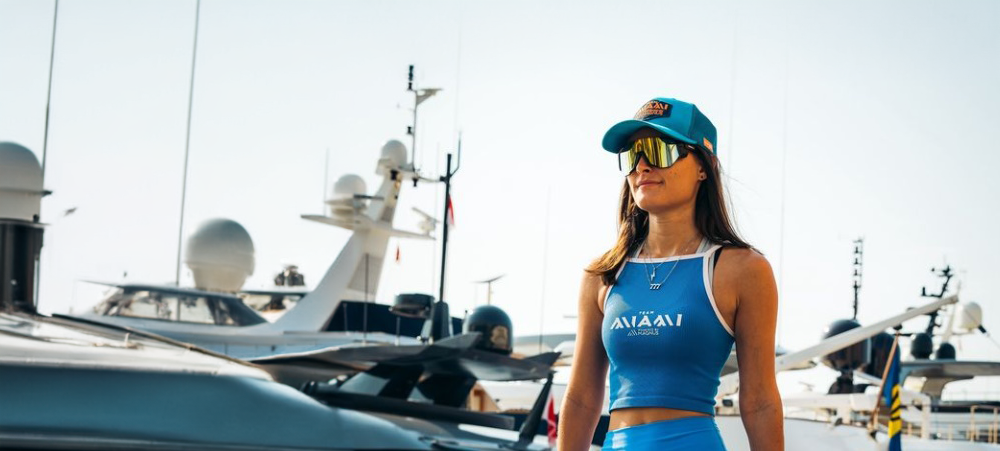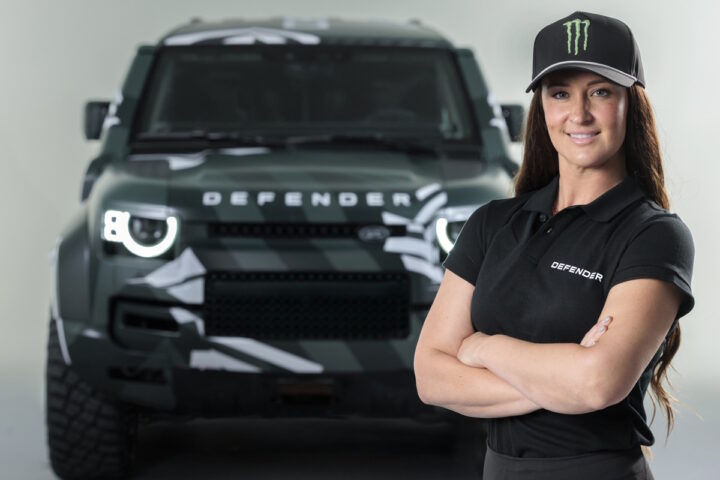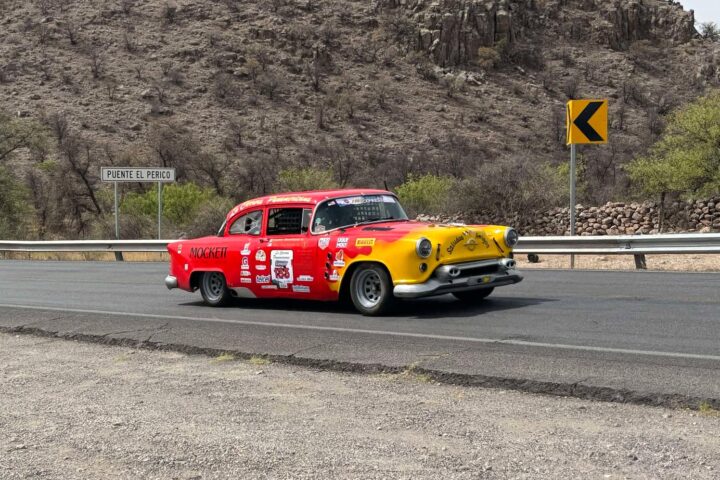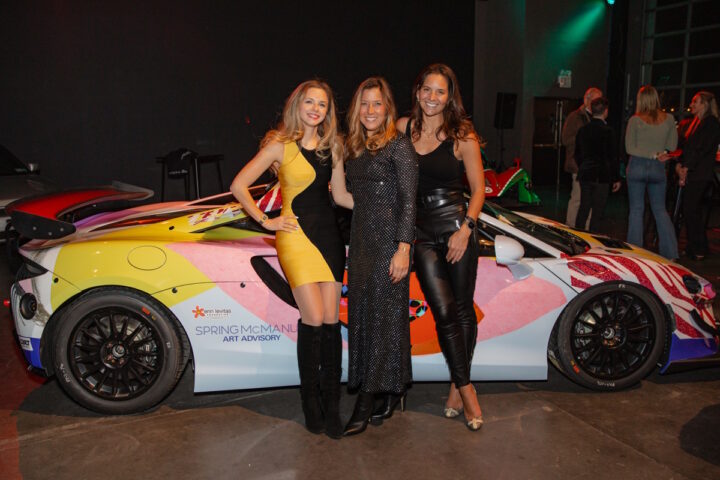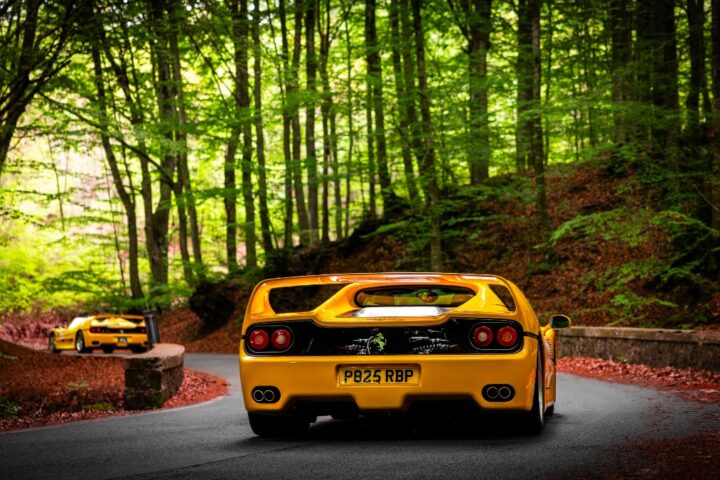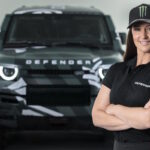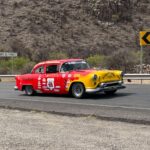by Michael Satterfield – Photos Provided by Anna Glennon – 07/22/2024
Growing up at Lake of the Ozarks with a master mechanic father, Anna Glennon was introduced to the world of motorsports from a very young age. Her childhood was filled with memories of working alongside her father on speedboats, motorcycles, jet skis, and hot rods, igniting a passion for water sports that would shape her future. By age 14, she had already built her first stand-up jetski with her father’s guidance, solidifying her love for the sport. Lake of the Ozarks’ unique boating culture and challenging waters played a significant role in honing her skills and fueling her enthusiasm for jet ski racing. With a supportive family, particularly her father, who insisted on hands-on learning, Anna embarked on a journey that would see her rise from local races to becoming a celebrated champion in a predominantly male-dominated sport.
TGR: Can you tell us a bit about your early life and how you first got into jet skiing?
AG: My father was a gear head with two daughters, he is a master mechanic who’s had his hands on speedboats, motorcycles, jetskis, and hot rods his entire life. I spent most of my childhood at his elbow or holding the flashlight in the garage. He never tried to force motorsports on us, but I know it was always something he nudged our way. I was riding sit-down jetskis with my parents when I was less than a year old, and I built my first stand-up with my dad when I was 14.
TGR: Growing up at Lake of the Ozarks, how did that environment influence your passion for water sports?
AG: I can say without a shadow of a doubt that spending every summer on the water affected the course of my life. Lake of the Ozarks holds a special place in my heart. It has the most diverse boating culture and some of the roughest water in the country. I learned how to drive boats and jetskis on that lake and developed a passion for watersports. Had I not grown up in that environment, I would not be where I am today!
TGR: What role did your family play in your racing career?
AG: As I mentioned, my dad was the driving factor for my involvement, and he had a strict program where I wasn’t allowed to sit on my hands. If I wanted to racing, I had to be in the garage working on skis with him, and putting in the sweat equity. My little sister spent a few years racing as well, and my mom was the glue that kept us together and kept us from throwing wrenches at each other in the garage!
TGR: Can you describe the moment you knew you wanted to pursue jet ski racing professionally?
AG: I remember it well! We went to a local race in Lawrence, KS, when I was about 15 years old. My sister and I saw young kids around the age of 10 racing, and I jokingly told my dad that we could easily do this. That was the only sign he needed! From there, he researched how we could compete in our first race, and we started piecing together our own program.
TGR: What was your first race like, and how did it shape your future in the sport?
AG: My first race was SO terrible. We showed up on skis that we had pieced together, I got roasted for wearing motocross gear and got last place. But we still had so much fun. Once my dad knew that my sister and I were into it, he started researching what we could do to the jetskis to have a better chance, and we started going to the lake even more so I could train. Maybe 3 races later, I went to the World Championships expecting to be a big dog and got my world rocked. At the time, I was devastated (I didn’t stand a chance!), but it made me realize that motorsport wasn’t just about me. On race day, you need a strong machine; you need to be strong, and if luck isn’t on your side – it won’t even matter. It was the start of a long battle for a World Championship title.
TGR: How did you come up with the name “Jet Girls Racing,” and what does it represent to you?
AG: When I started racing, my dad told me to point blank that I would need to learn how to market myself because he “wasn’t going to pay for all my crap.” Between the two of us, we came up with the name Jet Girls Racing. I was 15 at the time, and never imagined that later on I’d own trademarks, a brand, and a successful business simply from my old man telling me I wasn’t going to be a “daddy’s money racer”. The name means a lot to me; it’s a symbol of a time when my family was traveling the country together to race, and it’s a brand that really encompasses my identity. I built a life that I love from that discussion with my dad and kick-starting the Jet Girls Racing brand.
TGR: You’ve raced in various categories. Which is your favorite and why?
AG: As much as I hate to admit it, the four-stroke stock class has been my favorite. I had the fastest two strokes on the planet and went kicking and screaming to the four-stroke class when the rules changed… but I’ve found that this class is very even in terms of horsepower, and it’s made some of the best tight-knit bar to bar racing I’ve ever had. I have had some of the gnarliest passes and close-calls of my career in this class, and I’ve enjoyed learning how to harmonize with a jetski that weighs 650 lbs. It was like a puzzle for me to crack.
TGR: How do you prepare mentally and physically for a race?
AG: If you asked me this question 4 years ago, I’d have a list of regimes and pre-race rituals. These days, I’ve brought things back to why I started – to have fun – and my race results have been much better. I do spend a lot of time in the gym, but it’s more so to stay healthy and be able to move jetskis and lift fuel jugs myself. My race prep is focused a lot more in the garage these days, I spend a lot of time testing set ups and making sure my motors are ready for race day. Otherwise, I usually roll out of bed on race day, do a little yoga in the race trailer, and listen to music loud enough to annoy my pit-lane neighbors.
TGR: What challenges have you faced as a woman in a predominantly male sport?
AG: It’s interesting, I think there have been challenges, but there have also been advantages. In racing itself, I think my biggest challenge has been physical. For most of my racing career, I have weighed under 100 lbs. That’s made it challenging to strong-arm the jetski around the track and force it to do what I wanted. I will say, however, that racing the boys has, for the most part, been a blast. They show no mercy and normally have the least amount of drama. In 13 years of racing, I have had a lot of positive support from the men I’ve lined up against, even when I beat them.
On the flip side of that, in the professional field, I faced a lot of hurdles. The world of motorsport is definitely a boys’ club. Despite my background, skillset, etc., I was still outhired by men with fewer accolades than I had. I struggled with this for a long time, but I am now in a place where I feel well-respected.
The biggest thing I learned is that there is a catch-22 here. Sadly, a lot of misconceptions about women in motorsport are amplified by women who have created a negative stereotype – some guys have seen that and latched on to it. The women who are humble, smart, badass, strong, and understand motors and racing are sometimes subject to these stereotypes. I’ve found that so long as I keep my head up, and prove to people that I know what I’m talking about – the respect comes through from the right people.
TGR: Can you share your experience as the only woman to win the Men’s Classic Two-Stroke World Championship title?
AG: That was one of the coolest days of my life! In a two-race format, I started that day off miserably. In Moto One, I think I finished 7th because I simply could not pass another rider. In Moto 2, the water conditions got significantly worse, and all my time riding at the Lake of the Ozarks paid off. I passed several guys to get to the front of the pack and held it until the end. I think there were 20 boys on the line that day, and then there was me weighing in at about 95 pounds. My dad built a wicked-fast motor that year… and everything just finally came together. It was a huge moment for my family, as we fought against big-budget riders for years. Our little redneck garage program finally came out on top.
It means a lot to have been the only woman to ever win that class. There are not a lot of women who have won the mixed-gender classes at the IJSBA World Finals, so I’m proud to be among them.
TGR: How did it feel to win your first National Championship in 2013?
AG: This meant just as much as the World title, really. I spent 2013 on a ski with very few modifications and spent almost every race in the back and middle of the pack. My dad insisted I learn how to ride well first before he made my ski fast. We trudged along in the middle of the pack, collecting points, and at the final race, my dad said it was finally time to make that ski fast. I put a massive gap on everyone at the start, and they never saw me again. As much as I HATED getting stepped on all season, I think his method helped me develop tremendously as a rider. A lot of people get into jetski racing and go straight for the fastest ski they can get their hands on to try and get in front. There’s no point in that if you can’t ride it well.
TGR: Which achievement are you most proud of and why?
AG: As proud as I am of the titles, I think I’m most proud of the career I’ve built from jetskiing. Jetskiing itself didn’t make my career, but the person I grew into because of jetskiing made it possible for me to be where I am today. A lot of people disappear from the sport and never leave a mark. I’m really thankful for everything jetskiing has done for my life.
TGR: How do you stay motivated after achieving so much success?
AG: As bad as it sounds, I think it’s that “never good enough” mentality. My old man was a rough redneck, and he made sure I never had princess treatment. I saw what happened to people that rested on laurels or got lazy. I have a very “running for my life” personality. I feel like I need to clock as many useful minutes as I can. As I got older, this feeling got amplified because I started getting random calls with incredible opportunities. I feel like the harder I work, the more the phone will keep ringing.
TGR: What are some of your career’s most memorable races or moments?
AG: Haha, oh man, there are too many to list!
I will never forget going 3-wide into the first corner with two guys in Chicago. I had a guy’s buttcheeks bounce off my handlebars and still managed to pull out in front.
Racing in Pensacola, FL in 18-foot waves…. started my love-hate relationship with racing in the ocean.
My dad said, “Oh shit yeah!” when the technical director let us know we were sitting in first place at the World Championships.
TGR: How do you balance racing with your responsibilities as the owner of Jet Girls Racing?
AG: This is a great question – honestly, I don’t know. I have to make a lot of to-do lists to keep things together. For the most part, Jet Girls Racing is a single-man operation – and I’m the man! Since moving away from home to Lake Havasu City in Arizona, I now run the entire program myself. I’ve had to really pick up the reigns on building and maintaining skis, planning race schedules and getting myself to the races.
TGR: What training regimen do you follow to stay in peak condition?
AG: I work with a trainer several times a week. We focus mainly on general, functional strength. 3 years ago I could barely lift up a fuel jug to fuel the jetski – since starting a regular program, I feel a lot stronger and healthier in general. I’m not trying to body build or run any triathlons, I just want to be healthy and be able to function on my own! It has all been a positive contribution to my race day program.
TGR: Can you tell us about the different types of jet skis you race and what you like about each?
AG: Of course!
My primary race ski these days is a Kawasaki SX-R 1500. This is a 160-horsepower, four-cylinder four-stroke. The motor is very similar to what the guys are racing for street bikes. I race it in the Stock class, which limits modifications to the motor’s internals, but you have options on tunes, handling modifications, airflow, etc.
I also have a vintage 1989 440 with a rare PJS Viper motor transplanted into it. I had it painted to match my dad’s first jetski, and it’s a motor that we built together before I moved. This is a trailer queen, it’s gorgeous and I’m very proud of it.
I also have several tricked out Kawasaki SX-R 800 two strokes. Prior to the fourstrokes coming in, I had some of the fastest two cylinder two strokes in the world. My dad was a maniac building those. There’s photos of me hundreds of feet ahead of the competition on the start… it was insanity.
I have a few projects in the works right now that are a bit of a secret, but I’m excited for them!
TGR: How involved are you in the technical aspects of your racing equipment?
AG: Thankfully, my dad made me shadow him while I was growing up. If not for that, I don’t think I could have moved away from home and continued my race program. At this point, I manage all the mechanics myself. I still call home sometimes to bounce ideas off my dad, but when it comes down to it – if I want to get to the starting line I have to do it myself. If it’s broken, I have to fix it.
I’m fortunate enough to work with many brands that support me with resources and parts, but at the end of the day, it’s my hands in the engine bay.
TGR: What innovations or changes in jet ski technology excite you the most?
AG: After my involvement in the E1 electric powerboat racing series, I’m excited to see an electric jetski in the States. Do I think it will replace what we have? Not yet. But as a geek for development and testing, I love to see people innovating. We haven’t seen anything yet, but I just know the OEMs are working on it.
TGR: How has your background in digital media and communications helped your racing career?
AG: I have racing to thank for my career! I would not have gotten into media and communications if it hadn’t been for the hunt for sponsors. In the long run, it’s taught me so much about being a good ambassador and how to understand businesses. I think that a lot of athletes these days have an expectation of support and a lack of understanding that support is an advertising transaction. That has made all the difference in the world for my race program.
TGR: Can you talk about your experience working with various sponsors and the importance of these partnerships?
AG: Thanks to my dad forcing me to learn about marketing, I’ve been very fortunate to work with brands as big as NASCAR and OnlyFans as partners and sponsors. At this point, my race program has gone from a hobby to a source of income, and I feel blessed to be in that position – but it was achieved with a lot of work!
Partnerships are critical, and they are a two way street. Going around with your hand out gets you no where, but working hard and providing a useful service to brands will open a lot of doors.
Over the years, I’ve been criticized for “doing too much” on social media, and being annoying. But my work online and on social media is the reason I was able to buy my dog a house, and a bigger garage for my jetskis.
TGR: What advice do you have for young athletes on using social media effectively?
AG: The thing I hate to see… are “these are my results” posts. After every race, I see ten or twenty drivers making the same posts with captions that are nearly the same.
Your social media is an advertising platform. How can you expect to be sponsored when you are running the same commercial as everyone else? You are an advertising platform yourself. If you stand on the podium and simply say, “I want to thank all my sponsors; I have so many,” what advertising value does that have for the brands that support you.
It grosses me out to see racers complain about a lack of support and opportunities when they are doing the bare minimum and lack creativity. Those are usually the same racers who criticize the racers out there coming up with cool ideas.
Am I ranting? Probably. But as someone constantly criticized for what I do – it’s wild that people can’t see past their own noses.
Be creative, be bold, but most importantly – be real. You are a walking billboard, be the most unique and fun one you can possibly be – brands will gravitate toward you.
TGR: How do you manage your media presence alongside your racing career?
AG: I don’t know! I juggle a lot. But I genuinely enjoy sharing my story and goofy videos with people, and that keeps me working at it. It’s easy to get burnt out, but when I hear from people that they enjoy what I do or I inspired them in some way – that makes it worth it.
TGR: What are your goals for the upcoming racing seasons?
AG: With my new adventure and focus on powerboat racing, I think my biggest goal in jet ski racing is to stay competitive. I have an extremely busy schedule and don’t spend every day riding like some of the competition… to be able to still ruin someone’s day on race day is a treat for me. Above all else – I just want to keep having fun on my jetski.
TGR: What legacy do you hope to leave in the world of watercraft racing?
AG: Man, this one is deep. You know, I grew up inspired by Christy Carlson, one of the greatest female riders of all time. She was on ESPN in the height of her career with the world on her shoulders – and she stayed true to herself, she stayed positive, and she left a legacy that inspired a lot of women to ride. If I could ever leave a shred of light on the sport like she did – I’ll be happy.
TGR: What do you enjoy doing when you’re not racing?
AG: Fixing stuff I broke! Ha! I get a lot of joy when I solve problems. I enjoy reading, painting, and riding my jetski with my dog, Lucky.
TGR: Who are your biggest inspirations and role models?
AG: I’m very fortunate to have close relationships with my two biggest heroes. 10-time jetski world champ and arguably the best to do it – Jeff Jacobs – has been a riding coach to me and taught me a lot about mental toughness. Hanging out with him drastically changed my mental game. Christy Carlson was Jeff’s equivalent in the women’s class. While she hasn’t gotten to ride with me much, our pen-pal type relationship has taught me a lot about staying true to myself, navigating things like bullies, tough decisions, and paving my own way.
Outside of jet skiing, Michele Mouton is a huge role model for me. She had a sharp tongue and backed it up in a car. Guys were scared of her. I want people to have a little fear of me. Not because I am scary (have you seen me?), but because I want them to worry about what I am capable of.
TGR: What advice would you give to young girls who aspire to follow in your footsteps?
AG: The world is always going to try and change you. People will try to beat you down. Focus on yourself. Not in a selfish way, but focus on staying true to yourself above all else.
The thing I am most proud of is being able to look back on my life so far with no regrets on or off the race track. I made every decision based off my gut, and every post online or word out of my mouth was real. Am I everyone’s cup of tea? Probably not! But am I happy with who I am? Absolutely.
Follow Anna on Instagram @jetgirl_777 or visit her site at jetgirl777.com.

